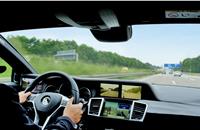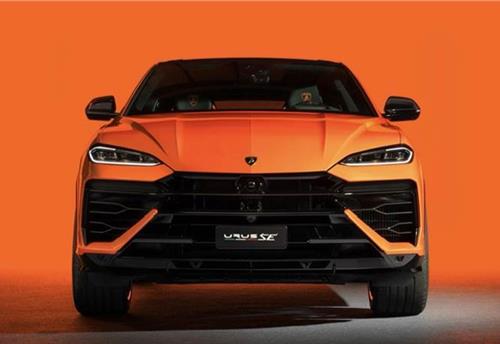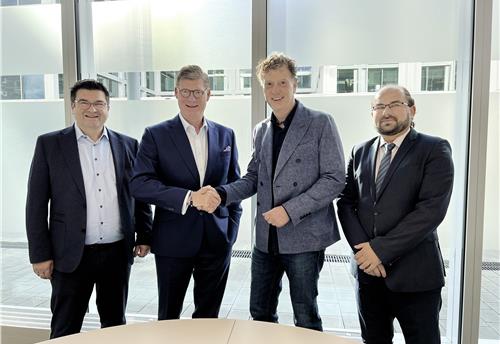Innovative camera monitor system replaces wing and interior mirrors
Continental used a prototype vehicle to demonstrate how a camera monitor system can replace a car’s exterior and interior mirrors.
Camera technologies are increasingly finding their way into a very wide range of vehicle classes. Automotive supplier Continental used a prototype vehicle to demonstrate how a camera monitor system can replace a car’s exterior and interior mirrors.
Three cameras are installed inside the test vehicle, and a different aperture angle is the technical difference between these and the Surround View cameras. Instead of the rearview mirror, the driver has two monitors with organic light emitting diodes (OLEDs) oriented in the usual viewing directions and displaying what is happening at the rear and sides of the vehicle.
In addition to giving the driver a wider field of vision, the system eliminates glare, provides traffic situation detection with driver assistance functions, is much less susceptible to dirt and dust, makes damaged wing mirrors a thing of the past and gives drivers better vision in poor light and rain. Vehicle fuel consumption is also reduced (less wind resistance) and there is less noise from the wind.
“There are no blind spots in this camera monitor system. The effects of unwanted optical phenomena such as glare and weak light can also be compensated,” said Alfred Eckert, director of the Advanced Engineering department in Continental’s Chassis & Safety Division. “By eliminating the wing mirrors, we have created an additional benefit, because the vehicle’s air resistance is reduced. The low cw value (drag coefficient) reduces fuel consumption and wind flow noise at higher speeds is diminished.” Unlike conventional car mirrors, the traffic situation is displayed indirectly using a camera, thus glare caused by low sun and by vehicles with their headlights on high beam is avoided. To provide the best possible display of the lighting conditions on the monitors, the cameras are equipped with a High Dynamic Range (HDR) function that reduces a bright sun, for example, to a white surface without flare. HDR also improves visibility at dusk.
The coated lenses of the wing cameras are less sensitive than conventional mirrors and have a smaller surface area where dirt and dust would normally collect. This improves the rear view even in bad weather. A cleaning function for the rear view camera lens is currently being developed.
With its digital ‘mirroring’ as presented, Continental says it implements the requirements for conventional mirror classes I and III, but the system goes further than this primary basic function. “Instead of the mechanical mirror, we rely on a driver-oriented and holistic human-machine interface (HMI) that not only creates better visibility conditions, but also opens up the possibility of providing situational instructions on the monitors,” said Dr. Otmar Schreiner, head of Research & Development at Interior Electronics Solutions in Continental’s Interior Division. If the approval of these camera-monitor systems goes through as planned in 2016, the systems could already be in use in vehicles starting in 2018. The relevant and internationally agreed technical regulation is UNECE R46 (United Nations Economic Commission for Europe Regulation 46).
Unobstructed view without physical contortions
The adaptation of the wing cameras to the chassis was achieved using small, pyramid-shaped housings in the window triangle. The third camera is unobtrusively integrated into the mirror base of the GPS antenna on the roof. The image processing system uses the images created by the three cameras to stitch together a corresponding image for each monitor. In addition to the usual mirror images, the driver’s field of vision is also expanded by areas he could not normally see. For instance, he can use different picture modes to get a view of the side and the rear of his own vehicle. Combined with suitable orientation, this image stitching (joining of the images) prevents any gap in the field of view, especially the accident-prone blind spots of conventional mirrors.
Instead of the usual wing and rearview mirror images, the camera images are displayed on OLED monitors developed by Continental. Thanks to the company’s own coating technology, this energy-saving monitor system is impervious to direct light, ensuring consistent readability of the monitors. The OLED displays are crystal-clear and consume less power than conventional displays.
In addition to the better view, the elimination of the wing mirrors also has a positive effect on the cw value, which means less fuel consumption as well as better vehicle interior acoustics. The reduced width of the vehicle also makes it easier for drivers to use the left lane in tight two-lane road construction zones.
Versatile future uses for the digital mirror
“The camera monitor system can also create more benefits for the driver than just mirror replacement,” said Marc Simon, project leader for Mirror Replacement in the Chassis & Safety Division’s Advanced Engineering department. Unlike conventional mirrors, digital mirrors also ensure a real improvement in traffic management thanks to the use of mono-camera-based object recognition and classification as a basis for advanced driver assistance systems functions. Critical vehicles, speeds and distances are displayed on the monitor at dusk and at high speeds, for example, which enables the driver to make decisions about maneuvers more easily.
In a holistic HMI, where the existing hardware and software can be dynamically adapted to the driver’s needs by networking, digital mirrors expand the possibilities of assisting the driver. They can increase the “situational awareness” of events in the traffic environment, for instance. Initial field trials and a Continental-own study have shown that digital mirrors are preferred to conventional models. Human testers found in particular that these images were easy to perceive and that the entire system was attractive to use.
Cameras as wing mirror replacements in commercial and special vehicles
Concerning commercial and special vehicles there are specific regulations. The wing mirror replacement must cover mirror classes II and IV. For it, Continental offers with ProViuMirror an own solution with a camera monitor system for the right and left side of the vehicle. Two cameras replace the wing mirrors on each side of the vehicle and transfer the images to 12.3 inch displays (1,920 x 720 pixel). They are mounted on the left and right of the A-pillar inside the cab. Through the abolition of the huge wing mirrors the visible area to the sideways front is clearly improved. Furthermore, the solution developed by the business unit Commercial Vehicles & Aftermarket enhances driving safety and reduces fuel consumption at the same time.
RELATED ARTICLES
Lamborghini unveils Urus SE ahead of Auto China 2024
Electric-only range of 60km helps reduce emissions by 80%.
ZF to display next-gen e-axle for low-floor city buses at Busworld Turkiye 2024
The AxTrax 2 LF is available with a continuous output of up to 360 kW and a peak torque of up to 37,300 Nm.
Daimler Buses and BMZ Poland to develop next-gen NMC4 electric bus batteries
The new battery generation NMC4 – succeeding the current NMC3 technology – will combine high energy density, resulting i...





 By Autocar Pro News Desk
By Autocar Pro News Desk
 21 Jul 2015
21 Jul 2015
 3893 Views
3893 Views












